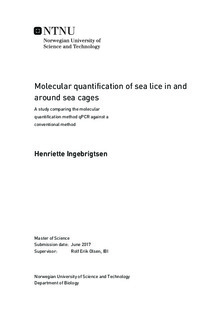Molecular quantification of sea lice in and around sea cages - A study comparing the molecular quantification method qPCR against a conventional method
Master thesis
Permanent lenke
http://hdl.handle.net/11250/2446614Utgivelsesdato
2017Metadata
Vis full innførselSamlinger
- Institutt for biologi [2526]
Sammendrag
The aquaculture production of atlantic salmon (Salmo salar) have been growing in a steady pace, but for further expansion of the industry it is necessary to solve environmental challanges, including those related to sea lice. The two most common species that are affecting salmonids in Norway are Lepeophtheirus salmonis (Krøyer) and Caligus elongatus (Nordmann), both of them included in this study. Identification of these pathogens involve preservation of samples and conventional methods like microscopy, a process being time consuming. The first part of this study looked at the effect of different preservation methods due to schrinkage, in addition to investigate if the DNA amount varied at the different planktonic stages. The larval size (length and width) at the nauplius I stage was found to decrease in samples preserved on 4 % formalin. Larvae at the nauplius II stage were wider when preserved on 4 % formalin, while no significant differences was observed due to cephalothorax width. At the copepodid stage, no significant differences in neither length or width was observed. The results did not indicate differences in DNA amount at the different life stages.
The second part and main objective of the thesis, focused on comparing two different quantification methods; counting of sea lice larvae in plankton samples using microscope and quantification of larvae using th molecular method, qPCR. As a part of this, the primers for L. salmonis and C. elongatus developed by McBeath (2006) was tested. Analyses revealed that the primer for C. elongatus did not manage to detect all the larvae in known samples. In contrast, the primer for L. salmonis was species specific, even managing to detect trace amounts of DNA in field samples. However, when comparing the counted amount of sea lice under microscope with the estimated amount found using qPCR, the results did not correspond to each other.
